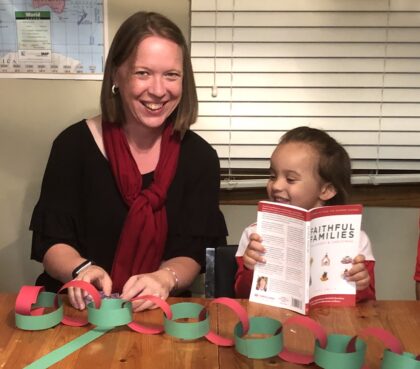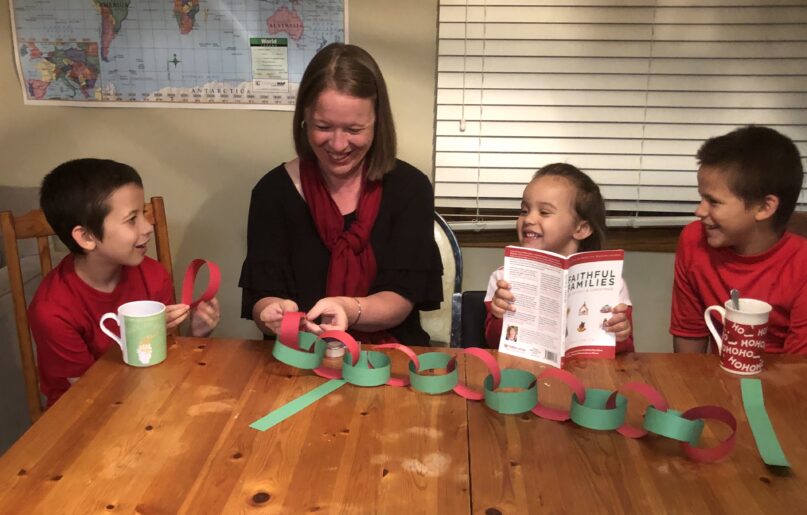(RNS) — The Rev. Traci Smith is a Presbyterian pastor and mother of three who has written several books chock full of ideas for helping families deepen their spiritual practice at home. Now, with “Faithful Families for Advent and Christmas: 100 Ways to Make the Season Sacred,” she brings that passion to the holiday season, making home a sanctuary of spiritual growth for parents and kids alike. This interview has been edited for length and clarity.
2020 will be remembered as the year we did almost everything at home, so your book seems perfectly timed to help people have a joyous Christmas even in a pandemic.
The original “Faithful Families” book was about sacred moments at home more generally, and that was well-received. When I conceived of this spinoff, I was imagining that families would be needing a respite from all of the parties and social obligations and shopping we would be doing! I think the shopping piece is something that we may still need to escape from, but the rest of it is all very different.
This year, we’ve had to do everything at home. Our own haircuts, even our own therapy sessions. We can do church at home, too.
I liked how you make it clear that parents aren’t expected to implement all of these activities and ideas. You say it’s better to choose two or three practices and do them regularly than to march through the whole book like you’re ticking them all off a list.
I’ve taken this career path now where I’ve learned about how children learn faith and how habits are formed. Routine and structure is so important in other areas of our lives, and it’s important in spiritual growth, too.
I always tell parents: Think of a habit you already have in your family, and build on that. If every day we change into pajamas, maybe that’s our cue to say a prayer or have a faith practice. The science says that it’s easier to tack on something to a habit we already have than it is to create a new habit from scratch. And having two or three faith practices that are done regularly is far more beneficial than learning a hundred new practices.
Can you walk us through the basic structure and ideas in the book?
The bookends of the book are the opening chapter on getting into Advent and the last chapter, which is about putting the season away. In between I go through decorating the house, family time, practices for giving, telling the story, Advent values, difficult moments, Christmas Eve, Christmas Day and the 12 days of Christmas. These were themes I thought parents and children’s ministers would latch onto.
And remember: You aren’t expected to do all of the practices or be overwhelmed by them. When you get a cookbook, you don’t feel that you have to cook every single recipe in it. Instead you say, “What would work for my family? What looks good that they will like?” If you take four recipes out of a cookbook, that’s not considered a waste; that’s a really good cookbook! It’s the same thing with the ideas in this book.
You offer ideas for hands-on activities to help us tell the story of Christmas. What’s an example?
That’s the heart of my philosophy: Faith is learned through practice, just like sports or cooking. It’s not just hands-on for children, but for adults, too. One idea I got a few years ago from other clergy is the ornament story, where everyone in the family brings an ornament from the Christmas tree and describes what it means to them. You could do this over Zoom. Tell people in your extended family that you’re going to get together and to bring a favorite ornament to talk about. It connects ordinary objects to sacred life.
Also, I like the idea of having a box at Christmastime and then putting one food pantry item in it every day during Advent, and then taking it at Christmas to a local food pantry to donate. There is so much more need this year, with the pandemic, and this practice also lifts us out of our own troubles.
One thing I especially liked is the chapter on difficult times, which acknowledges that Christmas isn’t always a happy time for everyone.

The Rev. Traci Smith creates an Advent paper chain with her children. Courtesy photo
That chapter wasn’t conceived specifically for the pandemic, but Advent in general reminds us of the people who are not with us. And there are all kinds of stresses around the holidays, and in our relationships — pandemic or no pandemic.
Some of the practices in there for me came from the work of Barbara Brown Taylor’s book “Learning to Walk in the Dark.” One is a Silent Night Star Walk. You go outside and meditate on the beauty of the stars. That was directly from Taylor’s book, in a scene where she is full of anxiety and goes outside to look at the sky. That’s something we can teach children: how to walk in the dark, how to find God in those challenging moments.
You talk about honoring the “Longest Night,” the Winter Solstice. How?
For the Longest Night for kids, simply light a candle and explain this is the day of the year when there is the least amount of sunshine and the most shadow. And that it’s good to really honor that and mark it. It creates space for kids and parents to know it’s OK to have the full range of emotions even during the Christmas season. The candle is a tangible reminder that the longest night doesn’t last forever: From here on, the days will get longer and the nights shorter.
Finally, what’s a holiday spiritual practice that you have carried over from your own childhood?
The Advent paper chain. When we were young, we would go to church and do the Advent workshop, where you’d make things to take home with you. Like make an ornament by pounding nails into tin. (Are churches brave enough to do that now? Would that even be wise?) That’s where I learned to make the Advent paper chain, which I do now with my own kids. You can add to it every day.
Related columns:
Advent ideas, crafts, and activities for your family






